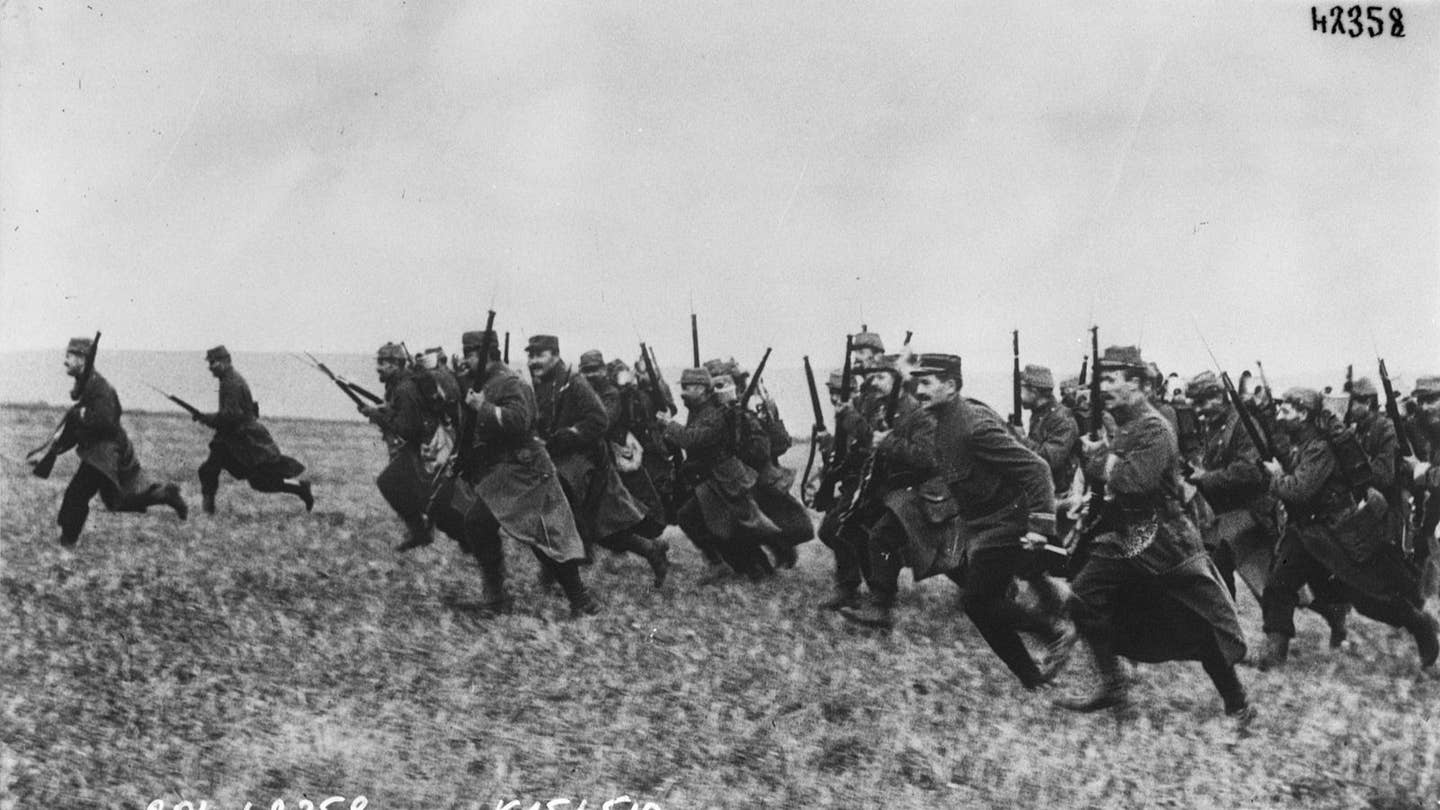World War I, France and the first Battle of the Marne

French infantrymen bayonet charge.
SUMMARY
In the opening days of World War I in August 1914, French and British military commanders were shocked at the speed and fury of Imperial German forces attacking through neutral Luxembourg and Belgium into northern France.
In contrast to the horrific images of static, the stalemate of trench warfare during most of World War I, the opening months of the war were highly mobile. French and British cavalry troops and their German opponents continually moved westward towards the English Channel, seeking to outflank each other, with the infantry and supply trains constantly trying to catch up.
By the end of August, the German army was only 18 miles/30 kilometers from the center of Paris and advancing towards the French capital.
Fear of losing Paris was running high. France’s loss in the 1870 Franco-Prussian War was still very much in living memory. When France’s Napoleon III, the nephew of Napoleon Bonaparte, attacked the German principality of Prussia in July 1870, it only took the Prussians and their fellow Germanic allies less than two months to turn aside the French offensive and lay siege to Paris beginning in September. The city endured daily artillery bombardments of 300-400 shells per day, and Parisians were soon suffering from starvation and disease. The siege continued for over three months until France surrendered in January 1871. Napoleon III abdicated his French crown, and a new French republic was formed.
The victory of Prussia and her allies quickly led to full German unification into a single nation when the King of Prussia was crowned Kaiser Wilhelm I of Germany, ironically in the French Palace of Versailles, the seat of French kings since 1662, just outside of Paris.
In the face of a second German siege, or even capture of Paris in 1914, the government of the French Republic evacuated to Bordeaux, and art masterpieces from the Louvre museum were crated up and sent outside of the city. On August 30th, a German plane flew over Paris and dropped three bombs, killing one civilian. The next day a German plane dropped a propaganda message stating the French army had been defeated in the field, and on September 1, another aircraft dropped bombs, killing another civilian and wounding 16.
The French army needed to bring up reinforcements quickly. Realizing that defending the Marne River crossing was the key to stopping further German advances, the French high command began rushing troops to the area as fast as possible.
At the time, trains were the most efficient means to move troops & equipment, however, if a strategic location was not near a rail line, slow horse-drawn wagons were the best resource for transporting equipment, and soldiers simply had to march.
As the Battle of the Marne progressed, a gap opened between two German armies, creating an opportunity to halt the German onslaught towards Paris if French troops could be poured into the gap quickly enough to prevent the Germans from solidifying their lines.
An idea came about using the Paris taxi fleet, which could each carry five soldiers and their gear to the Marne region from Paris, to aid in moving troops rapidly. The French commander-in-chief, General Joffre, ordered the mobilization of all available taxis, as well as other private vehicles in Paris to transport troops to the front lines. The military governor of Paris, General Gallieni, ordered police officers to requisition the taxis and other vehicles in the streets.
By 10 p.m. on September 6, 1914, 630 taxis were assembled on the Esplanade des Invalides, a large grassy plaza along the Seine River, adjacent to the Eiffel Tower in central Paris, no doubt to be highly visible to residents of Paris. The front lights of the taxis were blacked out, the rear lights dimmed, and the drivers were instructed to simply follow the lights of the vehicle in front. With the top speed of the 1905 vintage vehicles being 16 mph/25 kilometers per hour, this was probably easier than it sounds. The Renault Paris taxi fleet soon began transporting around 6,000 soldiers of the 103rd and 104th Infantry Regiments to the battlefront over the next two days, most making two trips and transporting wounded soldiers back to Paris on their return legs. Following city regulations, the taxis dutifully ran their meters, and the French treasury reimbursed the total fare.
Although the overall battle involved hundreds of thousands of soldiers on both sides, this move helped to turn the tide of the battle to halt the German advance, bolstered the morale of the French people, especially Parisians, and ultimately led to a French victory. The use of taxis in this way became a French symbol of spirit, resistance, and resourcefulness during the long war.
SHARE
